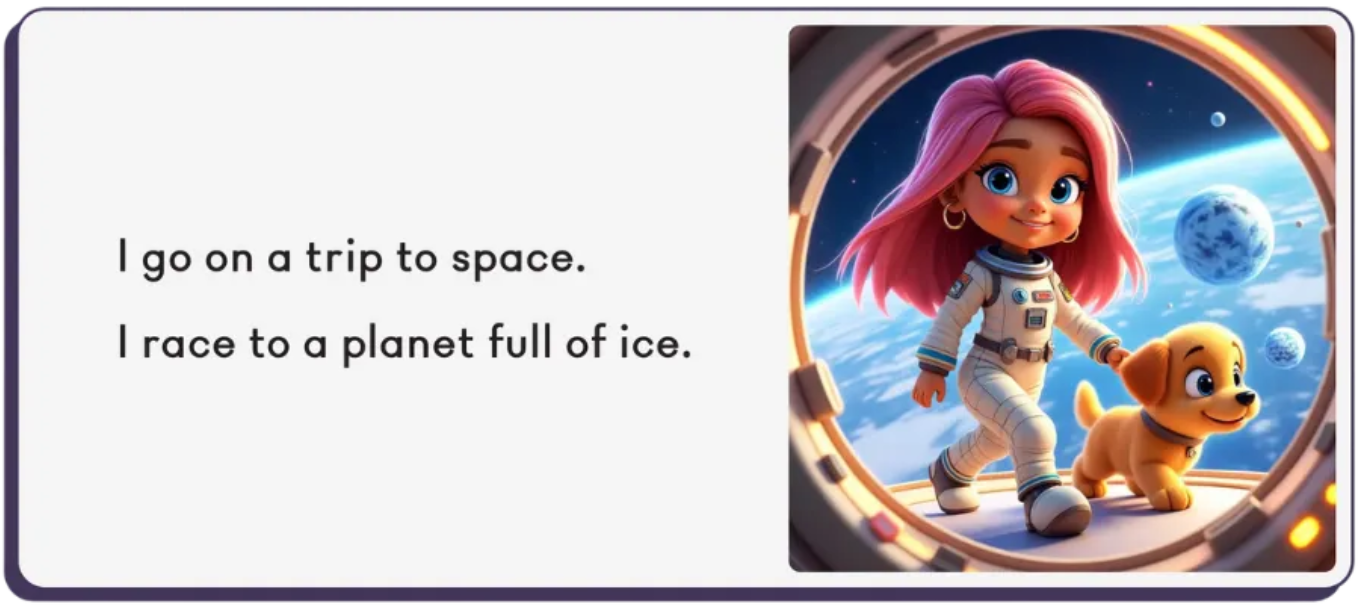1. Introduction
This case study examines the effectiveness of ROYO, a novel AI-powered interactive reading tool, in supporting reading acquisition in a child diagnosed with dyslexia, a language-based learning disability. The objective is to evaluate the extent to which the tool enhances reading fluency, word recognition, and comprehension compared to traditional print-based reading methods.
2. Participant
The participant is a 7-year-old female student in first grade with a clinically documented reading impairment, characterized by significant difficulties in phonological decoding and word recognition. Prior to the intervention, the child was a resistant reader who consistently displayed frustration and avoidance behaviors during reading sessions. She often complained before reading, repeatedly saying, “I can’t do it,” and required ongoing prompting to engage with text. Despite being provided with decodable books tailored to her skill level, she was unable and unwilling to independently read age-appropriate material with fluency or comprehension and was reading below grade level.
3. Materials
- Baseline Material: A set of print-based decodable books selected from High Noon Books, specifically Little Sprouts (Sets 3–4) and Dandelion Launchers (Sets 2–3). These texts are designed for early readers with language-based learning difficulties and feature controlled phonics-based vocabulary and simple sentence structures aligned with structured literacy practices.
- Intervention Tool: ROYO, an AI-enhanced interactive reading application designed for early readers. The tool includes real-time speech recognition, adaptive text highlighting, phonemic assistance, and embedded comprehension questions. It dynamically adjusts support based on user performance and provides immediate feedback to the reader. ROYO also includes customization features such as avatar creation and progress tracking.
4. Procedure
The evaluation consisted of two conditions:
4.1 Baseline Condition (Control)
The child was presented with the print-based decodable book in a quiet environment. No external assistance was provided. The child was asked to read aloud to the best of her ability. Observations included:
- Number of correctly read words
- Frequency of decoding attempts and errors
- Comprehension (via follow-up questions)
- Time spent engaged with the text
- Observable behavior and affect
During this condition, the child frequently expressed frustration, said “I can’t do it,” and showed low engagement and persistence when encountering unfamiliar words.
4.2 Intervention Condition (AI Tool)
Following the baseline session, the child was introduced to ROYO. The digital text was matched in complexity and content to the baseline material. The child interacted with the tool independently for the same duration. Observations included:
- Accuracy and fluency of reading with AI support
- Engagement with adaptive features (e.g., highlighting, pronunciation prompts)
- Comprehension (via in-app and post-session questions)
- Behavioral markers (e.g., frustration, motivation, attention)
In addition, the child became particularly engaged with the personalization features of the tool. She enjoyed creating a custom avatar before each reading session and often asked to design a new one. This act of placing herself in the story increased her emotional investment and contributed to greater motivation and focus throughout the reading process.
5. Results
Qualitative observations revealed a dramatic shift in the child’s engagement and reading performance. Notable improvements included:
- Significantly improved word recognition and reading fluency
- Correct responses to comprehension questions both during and after sessions
- High levels of on-task behavior and sustained attention
- Increased motivation and positive affect toward reading — the child began requesting to read with ROYO at the start of sessions, before any instruction
- Complete reversal of prior resistance and frustration — statements like “I can’t do it” disappeared, and reading became the most anticipated part of each session
- Progress from below grade level to on-grade-level reading ability
- No longer requires reading tutoring, demonstrating increased independence, confidence, and sustained gains
- Increased personal connection to the reading material — the child frequently created new avatars and was excited to see “herself” in the story, significantly boosting engagement and enjoyment
Quantitative results (e.g., number of correctly read words, reading rate, comprehension score) will be reported following full analysis.
6. Discussion
Initial findings suggest that the ROYO AI-based interactive reading tool provided highly effective scaffolding for the child, enabling reading performance that was not previously attainable through traditional print-based methods. The tool’s adaptive and multimodal support — particularly real-time speech recognition and responsive feedback — appears to mitigate core challenges associated with dyslexia, especially in decoding and processing.
The transformation from a discouraged, below-grade-level reader to an enthusiastic, on-grade-level reader underscores the potential of AI tools like ROYO to complement or even replace traditional interventions in some cases. The personalization elements, such as avatar creation, further deepened the child’s engagement and emotional connection to the reading experience. This case also highlights the critical role of the learner mindset in reading development: by reducing frustration and building agency, ROYO enabled the child to persist, succeed, and ultimately graduate from tutoring.
7. Conclusion
This single-subject case study offers compelling early evidence that AI-powered reading interventions like ROYO can have a profound impact on children with reading disabilities. In this instance, the child not only made significant academic gains but also developed a love for reading and no longer requires one-on-one reading support. Her journey reflects the powerful intersection of evidence-based instruction, learner engagement, and personalized technology. Further research with larger sample sizes is warranted to explore long-term outcomes and generalizability.




